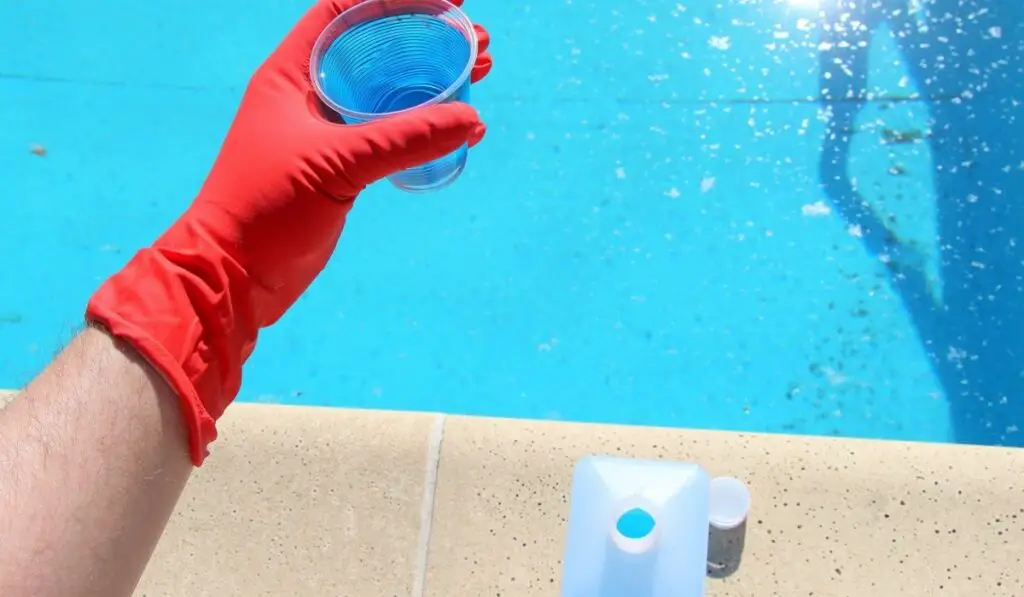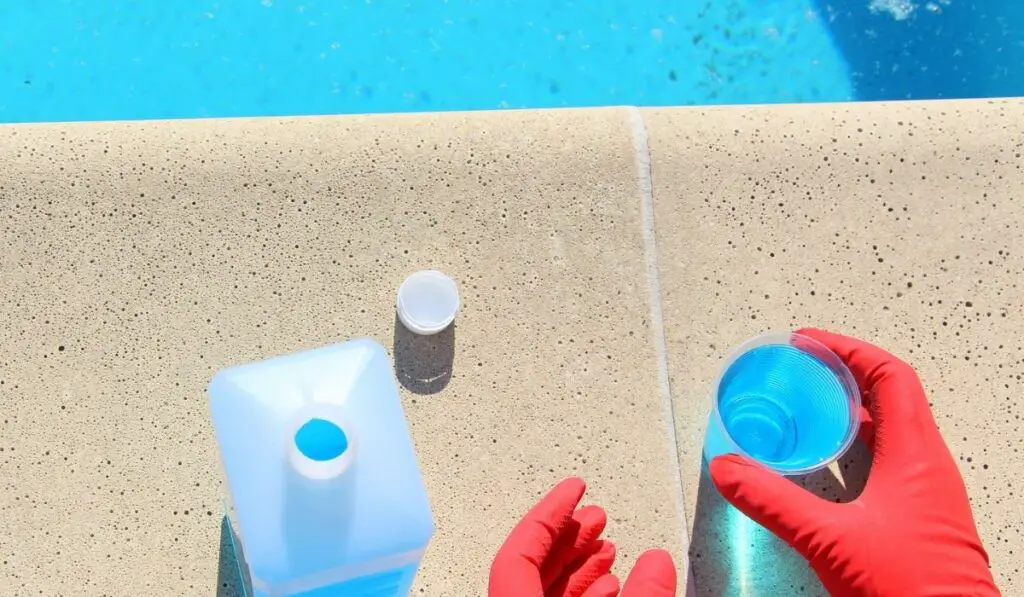Most people are well aware that pools don’t just contain pure water. Most of them also have the chemical chlorine, which works to kill germs in the pool and keep it safe for swimming. Viruses can cause issues like Swimmer’s Ear and indigestion problems if accidentally consumed, so it’s essential to keep the chlorine at an appropriate level — but does it have to be actual chlorine? If you don’t have any, could you add bleach instead?
You can use household bleach to treat your pool in a pinch. However, you need to be careful about the formulation and calculate the proper amount to use for your pool. This tactic requires more work and is less reliable than pucks or automated treatment systems designed for pools, but it can work.
It’s fine to use household bleach in a pinch, but it’s certainly better to use pool-grade chlorine in the long run. That said, if you’ve run out and need to treat your pool immediately, here’s everything you need to know about adding household bleach to pool water.
Can You Put Household Bleach in a Pool?

You can add household bleach to a pool, but you need to check the formulation. The higher the level of sodium hypochlorite (the chemical that both substances contain), the less you need to use.
You should also ensure there are no added fragrances and colors in your bleach as they can damage the pool system.
Differences Between Bleach and Chlorine
Although both bleach and chlorine contain the necessary chemical to keep your pool free of viruses, there are some differences.
Household bleaches contain less chlorine per gallon, which is the main reason you may end up having to use more in your pool. Chlorine also doesn’t last as long as household bleach, which is why you might find yourself in the situation of not having enough to put in your pool!
Generally, pool-grade chlorine (on Amazon) lasts about six weeks from the date of purchase.
The other differences can be summarized by this table:
| Household Bleach | Chlorine Solution | |
| Available Chlorine | 5-6% | 10-12% |
| Stabilizer? | No | No |
| Ounces to Raise a typical pool 1 ppm | 21 oz | 12.8 oz |
| Price Per Gallon | ~$2.60 | ~$4 |
As you can see, although pool-grade chlorine solutions are more expensive than bleach when judging it per gallon, it works out as the cheaper way to treat a pool because far less is needed. However, no need to beat yourself up if you only have household bleach, since you aren’t saving too much money in the long run.
It’s also much easier to use chlorine in a pool rather than household bleach because you can see how much of it you need at a glance. Bleach requires a lot more trial-and-error, and many people may get it wrong the first time because the concentrations are different and they’ve never used it before.
Worse still, they may accidentally use something with added fragrances or color because they didn’t realize what that can do to the pool.
The price per gallon does vary from place to place, so shopping around to get a deal is a good idea. If you’re not in a rush, taking your time can be very helpful.
Chlorine also has a slightly higher pH than household bleach. That’s another thing to keep in mind when figuring out just how much to put in your pool. You should continuously test the pH of your pool to make sure it’s the proper amount.
How Much Bleach Do You Need to Put in a Pool?
Clorox itself has its own recommendation, suggesting that you use 100-200 ounces of bleach per 10,000 gallons of pool water (1 ppm). If you’ve never done this before, then it’s best to start out on the conservative side; you’ll hear many different recommendations, and it’s better to initially add too little than too much, which could cause problems for your pool.
If you have an expert who can help you — whether it’s someone you know or someone in a pool specialty store — this can be very helpful. Keep an eye on how much you’re adding to your pool so you can note it for next time and then you’ll always know how much your specific pool needs.
Remember, this is for regular strength bleach, which contains about 5-6% available chlorine. If you read the label and that number is higher or lower, you’ll have to adjust accordingly.
You’ll also have to calculate the size of your pool, which many people don’t know by heart. You’ll have to measure three things:
- Length
- Width
- Average depth
Once you’ve done that and you have three numbers, multiply them together, which will you the volume in cubic meters. To get that number in gallons, multiply the number you get by 7.5. Ta-da! You’ve got your pool measurement. So the formula is: Length x Width x Average Depth x 7.5.
This is essential for calculating how much you need to use. Too much guesswork could give you a real disaster on your hands.
Many stores also sell stabilizers, which sounds like a great idea since they stabilize the chemicals the bleach releases. They’re usually dissolving tablets, so they do their work slowly.
However, it might be a bad idea to use these as they can actually have the opposite effect by stabilizing the chemicals that are trying to do their job by ridding your pool of viruses. Generally, stabilizers are not needed as long as you’ve used the correct amount of bleach or chlorine.
How Long After Adding Bleach to the Pool Can You Swim?
How long until it’s safe to swim very much depends on what you added to the pool, so it’s best to keep checking the chlorine levels. Generally, it’s safe to swim with a chlorine level of up to 5 ppm.
This might be twenty minutes after adding pool-grade chlorine or as long as twenty-four hours after adding bleach, as the chlorine level will dissipate over time.
If you put too much chlorine in your pool or swim too quickly, you could end up with issues such as rashes, trouble breathing, and congestion. Those with asthma may have particularly bad side effects.
What Happens if You Put too Much Bleach in a Pool?

Too much bleach in your pool can pose a danger to the people who swim in it. There are a lot of possible problems it can cause:
Irritation
You could end up with some extreme eye, ear, and lung irritation if you swim in a pool that has too much chlorine. Although people think they might be able to smell chlorine if the level is too high, it’s impossible to detect through scent alone, which is why it’s essential to test it.
Asthma that is affected by external factors can get particularly bad when there’s too much bleach in a pool, going as far as to cause an asthma attack.
Poisoning
The worst-case scenario is that the bleach may end up poisoning you. If your chest gets tight, you’re wheezing, or your vision is blurry, there may have been far too much bleach in the pool.
The good news is that it’s impossible to be allergic to chlorine, but the bad news is everyone is susceptible to being poisoned by it.
If you do think you’ve been poisoned — even if you leave the pool and experience the effects afterward — it’s important to see a doctor right away. Although rare, untreated chlorine poisoning can lead to death in severe cases.
Ruined Water
You could actually ruin the water entirely. While this may not seem like a huge deal since it’s just water, it can lead to you having to drain your pool. This is a problem as draining a pool can be a bit of a hassle.
In most states, it’s illegal to drain it into the streets and impossible to contain it in your yard.
That means draining it through the sewer line.
Damaged Pool Equipment
You could also damage the equipment in your pool such as the pump, filter, chemical feeder, and more. That would mean having to pay a lot to replace or repair them.
What Should You Do if You Added too Much Bleach?
If you added too much bleach to the pool, there are a few things you can do to try and bring the chemical levels back down to normal.
Leave It Alone
The first thing you should do is to leave it alone. Stop adding bleach, chlorine, or any other chemical — it’ll only make things worse. If it’s a sunny day outside, it’s an especially good idea as the sun will bring the chlorine levels down quickly.
You may be tempted to keep messing with it in an attempt to fix it, but patience is key in a situation like this.
Add Water
If you only added a little too much bleach and need to even it out, draining a little water and adding more fresh water to the pool can balance out the level.
This might work because if you’re only draining a little water, you can drain it into the yard. Make sure you attach a hose to the pool and drain it into different spots in the yard to ensure there isn’t too much chlorine for your grass.
A small amount of chlorine shouldn’t be a huge issue, but again, this is only if your chlorine levels are slightly elevated. If they’re way too high, it isn’t a good solution.
Buy a Dechlorinator
A dechlorinator (on Amazon) will help get rid of any chemicals in the pool, mostly chlorine. You can get one and pour it into your pool and let it work its magic, which may be a better solution if the levels in your pool are extremely elevated.
Heat the Pool
If you’re fortunate enough to have a heated pool, you’re in luck. Heat causes the bacteria to multiply even more, which means it’ll use up more of the chlorine attacking it. Raising the temperature of the pool for a while can see the chlorine levels drop pretty drastically.
